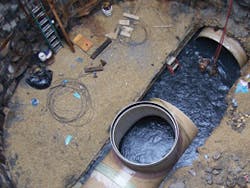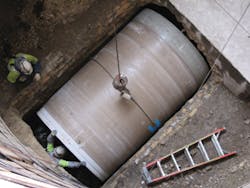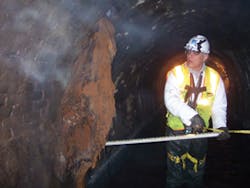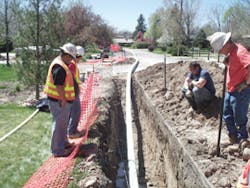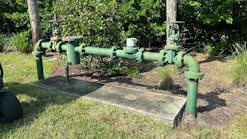With so much talk about America’s aging infrastructure in recent years–coupled with the harsh reality of tight budgets in a tough economy, water purveyors and municipalities need creative, cost-effective approaches to making improvements. Increasingly, alternative approaches to methods like open cut are in demand–and advances in pipe materials used in either complete replacements or pipe repair are making these alternative approaches possible.
Such was the case for the Metropolitan Utilities District (MUD) in Omaha, NE, which began an Infrastructure Replacement Program to replace over 1,200 miles of cast iron water mains over the coming decades using trenchless technologies to minimize costs, shorter installation times, and disruption to the public, starting in its historic Old Market District. In fall 2009, MUD replaced more than 2,500 feet of 10- and 12-inch-diameter cast iron; lead joint water mains; and as small and large service connections, fire lines, valves, and hydrants installed back in the 1880s and 1890s. The Old Market district, a manufacturing and warehouse district that was saved from demolition and redevelopment in the 1970s, now features businesses operating in realistic period surroundings and horse-drawn carriages and a weekly farmers’ market.
Minimal disruption to brick and cobblestone streets and granite and sandstone curbs, which would have resulted from the traditional open-cut method, was crucial. Still, the replacements were necessary, with MUD averaging about 400 breaks or leaks per year. In addition, MUD had traditionally received numerous customer complaints about poor water pressure and taste and odor. The cause of the problems was clearly unlined metal pipes experiencing internal corrosion, which results in tuberculation that reduces water flow and pressure.
Replacing the pipe in the Old Market district using any method posed several challenges. Replacing brick and cobblestone pavers would carry high costs. Both workers and the public needed to shops, restaurants, apartments, and condominiums while work was underway and pedestrian and vehicular traffic had to be maintained. The MUD had to provide a safe environment with thousands of tourists in the area each day and work around numerous other underground utilities, yet work could not take place in the late afternoon and evening and on weekends. The work had to be finished as quickly as possible amid vocal and political resistance to the prospect of prolonged construction activity.
With these challenges looming, the MUD had three choices. With traditional trenched replacement, more than 11,000 square feet of brick and cobblestone pavers would have to be removed and replaced over an estimated five-month period. Trenchless replacement also promised to be highly disruptive. Jeff Schovanec, P.E., senior infrastructure replacement design engineer for the MUD, also explored standard horizontal directional drilling (HDD), pipe bursting, and sliplining within the trenchless replacement category. Among other shortcomings, each of these construction techniques requires an excavation at the main to reconnect individual water services–the very situation the MUD sought to minimize with trenchless rehabilitation.
Schovanec had seen a presentation on structural lining, which was one of the first trenchless alternatives he was drawn to and subsequently explored. As it turned out, no other rehabilitation technology that he researched was better suited to the Old Market district. With trenchless rehabilitation, a fully independent structural liner could be inserted using relatively few excavations. Large services and fittings such as tees and crosses still had to be excavated, but small services could be robotically reinstated from inside the pipe, eliminating 32 excavations. Despite never having used the trenchless rehabilitation method, MUD decided to use this method in this case.
For the repair material, MUD chose the cured-in-place pipe (CIPP) liner Aqua-Pipe, which structurally rehabilitates deteriorated pressure pipes. It had been used for eight years in North America; more than 1 million feet had been installed in water mains. The liner is made of two woven seamless polyester jackets with a polymeric membrane bonded to the inner jacket for watertightness. A proprietary epoxy resin is used to cure the liner and adhere it to the host pipe. Small diameter services are reinstated from inside the pipe using a remote-controlled robot.
Hackensack, NJ-based general contractor J. Fletcher Creamer & Son, Inc. was awarded the
project and subcontracted Varennes, Quebec-based Sanexen Environmental Services to structurally line the water mains with Aqua-Pipe. In all, 1460 feet of 10-inch diameter and 1090 feet of 12-inch diameter mains had to be cleaned and lined. Creamer installed a temporary water supply in the curb lines and then excavated access pits. Sanexen inspected the main using a CCTV camera to verify adequate cleaning and to locate active and abandoned service connections. Plugs were then inserted in all service connections smaller than 2 inches to prevent resin migration into the service during subsequent structural liner insertion.
Moments before, and during, liner insertion, the liner was impregnated onsite with adeteriorated and capacity-limited interceptor in Montgomery, AL.
All told, 10 access pits were excavated and backfilled and nine structural liners were installed. Robotics were used to reinstate 32 small services and plug 35 abandoned small services. The construction team made 17 service excavations that reinstated 19 large services. Additionally, two hydrants and 31 main line and service valves were replaced.
The use of trenchless rehabilitation limited the structural lining and small service replacement portion of the project to only four weeks and the entire project lasted 14 weeks. The final cost to structurally line 2,550 feet of 10-and 12-inch cast iron water mains was nearly $1.1 million, but MUD estimates that trenchless rehabilitation of the water mains saved nearly $200,000 compared with trenched replacement.
Schovanec reports that the MUD used structural lining in an emergency repair situation in 2011and is exploring the viability of structural lining as a significant component of its infrastructure replacement program.
Schovanec contends that a municipality cannot communicate too much with its customers during rehabilitation projects. In addition, “Not every replacement/rehabilitation technique is suited for every situation–it is critical to ensure that the technique is appropriate for the situation,” he says. “That’s why we’re exploring various trenchless techniques. Ultimately, we want a full array of replacement and rehab techniques from which to choose so that we maximize our efficiency while minimizing cost and inconvenience to the public.”
Pipe Bursting Saves Money a Mile High
Pipe bursting turned out to be an effective approach to replace about 23,000 lineal feet of pipe for the Consolidated Mutual Water Company, which distributes approximately 4 billion gallons of water annually to 90,000 residents in Lakewood, Wheat Ridge, and unincorporated portions of central Jefferson County, CO, in 2010. Consolidated was formed in 1926 from four smaller, well-based systems, and its network grew over decades of additions, expansions, and reorganizations. Since the mid-1950s, the company has annually budgeted money for corroded ductile iron water main replacement and upgrades of other aging infrastructure, typically using the open-cut installation process. Over the years, though, the cost of open-cut installation continued to rise, particularly paved street restoration, so Consolidated began evaluating alternative methods.
According to Mike Queen, president of Consolidated, “Sixty-five percent of our water distribution system is over 50 years old. Like everybody else, we don’t want to get behind the eight ball.”
However, about one-third of the cost of the open-cut methodology is the full-depth trenching and asphalt restoration. Milling and repaving must be done to the edge of the curb and gutter, he points out. “So, basically, you’re rebuilding half of the road anytime you do a pipeline project,” he says, adding that increased petroleum and aggregate costs have also contributed to the costs of pavement replacement in recent years.
Consolidated selected Underground Solutions’ Fusible PVC pipe as the replacement pipe. A proprietary PVC formulation and patented fusion process are designed to yield a monolithic, gasket-free, leak-free system. The company cited corrosion resistance, ease of connection, and ability to upsize old cast iron distribution lines while minimizing soil displacement due to a smaller pipe outside diameter in its choice of pipe material.
“When we actually approached this pipe bursting process, we weren’t really looking for large savings as much as a different methodology that was less invasive to the neighborhood, the street,” says Queen. “We average around $112 a square foot for open-cut, and when it was all said and done, our costs came in at $54, so we’ve basically cut the cost in half.” He adds that when Consolidated looked at the replacement cost initially, it projected a cost of $58 per square foot.
In February 2010, Consolidated sent two employees to be trained and certified to fuse the pipe and purchased fusion equipment from McElroy Manufacturing and pipe bursting equipment from TT Technologies. The company also enlisted the technical assistance of Wiedenmann & Godfrey Construction, Inc., Belton, MO, which had experience using the same replacement method and pipe material in the Kansas City, MO, area.
The project started on April 26, 2010, and was completed on September 10, 2010, with minimal disruption to customers and traffic. Consolidated installed 23,000 lineal feet of 6- and 8-inch DR18 Fusible C-900 and also upsized 4-inch lines to 6-inch, and 6-inch lines to 8-inch. Queen can attest to the efficiency of pipe bursting on this project: During one week in late June, Consolidated replaced 980 feet in three hours–a company record. “That’s a two-and-a-half, three-day project with open cut,” he says.
In 2011, he reports, crews are replacing 2,600 lineal feet of pipe per week compared with 1,300 lineal feet per week in 2010. With the need for only two machines, the equipment requirements are much lower for pipe bursting than for open-cut replacement, Queen adds, referring to an excavator, loader, tamper, and trucks for hauling away spoil.
Consolidated saved $1.3 million using pipe bursting instead of the open-cut method on this phase. By the end of 2011, 34,000 feet were expected to be replaced. Queen also projects the lineal footage replaced at 40,000 feet in 2012 through the use of pipe bursting and for the entire project to be completed in eight to nine years.
Besides the time and cost savings with pipe bursting, Queen points out public relations benefits to this method. Having done underground pipe work for 32 years, he has experienced his share of dust, truck traffic, and complaints from residents. “Last year, we started getting thank you cards, people baking brownies for the guys, people asking when we were coming to their street,” says Queen. “Now neighbors know that we’re only going to be a week, rather than two or three with open cut–it’s not nearly as invasive.”
CCFRPM Suits Interceptor Replacement
Cost was also a primary consideration in the $75 million Catoma Wet Weather Improvement Program in Montgomery, AL. During the latter part of the past decade, the Montgomery Water Works and Sanitary Sewer Board needed to make major upgrades to its Catoma Water Pollution Control Plant (WPCP) and conveyance system. Phase I included the $16 million construction of a 45-million-gallons-per-day (mgd) pump station and 48-inch forcemain to convey raw sewage to the WPCP as a supplement to the existing pump station. Phases II and III involved construction of a 13-mile sanitary sewer interceptor to replace an existing, deteriorated and capacity-limited interceptor.
The $28.6 million Phase II project involved installation of approximately 6 miles of 30- to 78-inch–mostly 60- and 66-inch–centrifugally cast, fiberglass reinforced, polymer mortar (CCFRPM). The $30.6 million Phase III project included about 7 miles of mostly 78-inch-diameter CCFRPM and four microtunnel undercrossings (two 96-inch-diameter steel casings and two 78-inch-diameter CCFRPM direct-jacked sections), and crossing numerous environmental sensitive wetlands and creeks. Phases II and III occurred from August 2006 to
August 2009.
The Consolidated Mutual Water Company recently
replaced about 23,000 lineal feet of pipe using
PVC as the replacement pipe material in a largescale
pipe-bursting project in the Denver area.
David Stejskal, P.E., Pensacola, FL-based project manager for consulting, design, design-build, operations, and program management firm CH2M Hill, notes that the old pipe was reinforced concrete with an asphaltic coating added for corrosion protection that was installed in the mid-1970s. He adds that numerous sinkholes were discovered above the crowns of the existing pipe. The pipe network was evaluated and it was determined that the most critical areas were in the upper portion; these were prioritized, resulting in the two phases.
“After discovering some issues with the pipe, sinkholes, and such and TVing it; seeing the failing coating; and seeing the exposed rebar, we went back and did an investigation and core sampling, and we saw deterioration with pipe being half as thick as it was designed to be,” he says.
For both phases, HOBAS CCFRPM was selected as a replacement. These pipes, manufactured in diameters from 18 to 120 inches and various section lengths, are manufactured via a centrifugally casting method using a computer-controlled production process. They are also inherently corrosion resistant and provide for a 50-year design life. The pipes have thin-wall construction and a resulting oversized inside diameter for high flow capacity; according to the manufacturer, because of a smooth inside diameter, the pipes can yield significant energy savings for pumped systems and provide higher flow capacities for gravity-flow applications. The pipes’ lighter weight allows installation using smaller equipment. Their gasket-sealed, push-together joints eliminate the need for bonding agents, bolts, or welding and provide a leak-free system.
The selection of pipe material was methodical, Stejskal says. “We went through a very detailed evaluation and produced a quite extensive memorandum that we developed evaluating alternatives from concrete pipe to polymer concrete pipe to HDPE pipe and then [CCFRPM], which was HOBAS. We looked at ductile steel pipe, too. If there was a pipe out there, we looked at it, and the criteria we wound up establishing as the basis for our evaluation was that we wanted a pipe material that was corrosion-resistant throughout the pipe. That knocked out any pipe that relied on coating or a lining, which meant ductile iron pipe, steel pipe, or reinforced concrete pipe–that was the primary reason why they got knocked out. That left us with polymer concrete pipe, HDPE pipe, PVC pipe, and [CCFRPM].”
PVC pipe diameters were too small for the 78-inch requirement in many areas of the project, Stejskal says. While intriguing, polymer concrete pipe was rejected, too.
“We didn’t have a history of installing that pipe, and we didn’t have a comfort level” to use it for the first time on such a large-scale project, he explains. CH2M Hill wound up choosing the CCFRPM because the firm was able to obtain permission from the Alabama Department of Transportation to direct-jack the pipe underneath federal highways, eliminating the need to install a steel casing pipe. Stejskal reports that direct jacking saved about $2 million on Phase II.
David A. Dickerson, P.E., MBA, South Texas Area manager for S.J. Louis Construction of Texas Ltd., points out that when direct-jacking the 66- and 78-inch HOBAS Flush Jacking Pipe through soft, running sand subsurface conditions, it was crucial that the microtunnel drives were installed within tolerances of alignment and grade. Conversely, when installing HOBAS FWC Coupling gravity sewer pipe inside steel casing, the gravity sewer pipe could be slightly adjusted to maintain proper alignment and grade. Dickerson adds that the lighter weight when compared to some pipe materials of similar diameters makes installation more cost-effective and faster. S.J. Louis Construction had used HOBAS pipe for many years prior to this project, and Dickerson says that the keys to a successful installation are proper joining of the pipes to prevent joint leakage and proper bedding and encapsulating of the pipe to prevent pipe deflection.
The installation process involved first excavating the trench and installing safety shoring. Bedding rock was placed in the bottom of the excavation to bring the sewer pipe to proper grade and provide a support cushion for the pipe barrel. The pipe sections were connected utilizing the HOBAS FWC Coupling joint system, a male-to-female connection system. The spigot end is pushed into the bell end and the FWC Coupling utilizes a rubber gasket fabricated into the coupling that compresses upon pipe engagement, creating a watertight seal. The alignment of each pipe to the previous pipe was checked to make sure it is installed straight and true and the rubber gasket was checked to ensure that the seal was tight. Bedding rock was then placed all around each pipe, typically at a 12-inch depth over the top. Trenches were backfilled with soil and compacted for density. The units were later tested for leakage and deflection.
“To my knowledge, this was the first time that the state ever allowed direct-jacking of pipe under federal highways,” says Stejskal. “The direct-jacking was pretty advantageous,”
Stejskal notes that the project was completed with only $140,000 in change orders. “That’s pretty small,” he concludes.
PVC Used in Critical Repair
A thorough evaluation of a new lightweight PVC material resulted in its selection and the construction of a pipeline along State Highway 178 in Ridgecrest, CA, that successfully replaced an existing 25,000-foot steel pipeline in 2010. A parallel line was installed to avoid the exorbitant cost of excavating eroding steel.
Searles Valley Minerals (SVM) of nearby Trona, CA, which is responsible for the waterline that supplies potable water to Trona, Ridgecrest, and several SVM processing plants, hired Marmac Field Services, Costa Mesa, CA, to construct a parallel pipeline. The leaky steel pipe caused visible puddles of water on the shoulders of the highway. The fear was that water seepage might cause the soil under the highway to compact and cause the pavement to collapse into a sinkhole. Additionally, erosion had likely reduced the thickness of the original pipe from one-fourth inch to about one-sixteenth inch.
As it was, repairs often had to be made on the existing pipe in reaction to pipes bursting and water hammer issues resulting from high uphill flow of water pumped from a well, recalls Sam Tenorio, project manager/engineer with Marmac. “The way [repairs were] handled before was with clamp repairs,” he says. “When we uncovered certain sections of the pipe, we actually noticed a couple of repairs that had been made a couple of times. More than a couple of times, actually, we had pipes burst while we were out there.”
When Tenorio first analyzed the project for SVM, the steel pipeline was experiencing two new leaks per week. That number doubled by the time the project was approved in 2010.
The pipe material selected for the project was JM Eagle’s Ultra Blue C909, a lightweight molecularly oriented PVC pipe also known as PVCO. The product has a 50-year warranty. Each section of 6-, 8-, and 12-inch pipe can be lifted and moved by one worker, compared with the two or three men needed to install a section of pipe made of ductile iron, steel, or concrete. The material can be cut with a fine-toothed hacksaw, hand saw, or a power saw with a steel blade or abrasive disc. The joint connection is a push-on assembly that eliminates the need for a welder. The lubricated spigot end is inserted under the rubber gasket and into the bell end of the pipe.
“It wasn’t my first choice, to be honest,” says Tenorio of the C909. “I had considered either [JM Eagle’s] HDPE or C900. I called JM Eagle for further clarification, and they gave me more information and I read up on the specifications, and it seemed like a better product overall–it was a good choice.”
Tenorio says that the C909 was ultimately chosen for its relatively high compressive strength, deflection, and tensile strength. HDPE promised to be more expensive to install during the summer months. The C900 pipe looked like it, too, would be slightly more expensive to install. “Even though the C909 was a couple of cents higher, it gave me more flexibility in regard to maneuvering around and the possibility of adding a tap into the pipe itself rather than adding a mechanical joint,” he says. “Nobody had ever really used this product before. Normally, the way the industry works is that you follow everybody else’s lead. This was one of those projects where it was a case of who is going to try it first? I took a little bit of a risk, the numbers came out for me, and it turned out to be a successful project.”
Installation turned out to be very efficient. Marmac completed the project two weeks early, and Tenorio says he has never seen the crew work as fast in six years. In fact, he discovered that he could free up one or two members of his 12-man crew to fix leaks and still stay ahead of schedule. Most importantly, the new pipeline has shown no sign of leaks to date.
